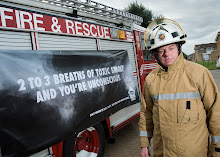Bedfordshire and Luton Fire and Rescue Service (BLFRS) identified Command and Control training as a Level 1 priority within its corporate plan for 2008/09. As a result, a new Incident Command training facility was developed, which was completed and used for the first time in 2010.
Now, as a further development, BLFRS was to use the facility as part of two multi-agency exercises in March and May this year.
Station Manager Derek Hobbs, who is now responsible for the management of the “Incident Command Suite” (IC suite) reports that capital budget was made available for the project in 2008/2009, allowing for ground work and the construction of a modular building on BLFRS Headquarters site. Various Incident Command training packages were evaluated and the Fire Studio system, which is already used by a number of other Fire and Rescue Services, was eventually selected. Fire Studio provides realistic graphics and sound to produce images of a developing incident. One advantage of this software is that it can be used to tailor incidents to service risks.
During 2009 the information technology and control systems for the IC suite were specified and in 2010 the systems and software were installed. In late 2010 and early 2011, five High Rise Incident Command Training Courses were delivered, using an external provider Peter Stanley Training. These were based on Level 2/3 incident command at High Rise incidents. During 2011 the Service plans to deliver continuation training for Flexible-Duty System officers using the IC suite.
Exercise Watermark
During 2010, while the IC suite building was in progress, the Bedfordshire and Luton Local Resilience Forum (BLLRF) started planning for national flooding Exercise Watermark. BLFRS suggested that the new IC suite might be used as a venue for part of the exercise and this was accepted by the planning group. It was agreed that the multi-agency Tactical Coordinating Group (Silver level) for Exercise Watermark would operate from the IC suite's main meeting room. The exercise players would benefit from on-site access to such facilities as the Service Mobile Data Terminals (MDTs) which include risk information, mapping, flood risk area overlays and cordon plotting; and multiple display screens with internet access. They would also be able to view the BLLRF website, which was used to hold emergency plans such as the Multi-agency Flood Plan, and view and update the BLLRF Emergency Log for the exercise.
Fire Studio Software
Towards the end of 2010 the Service was contacted by Central Bedfordshire Council (CBC) which has responsibility for Sandy Petroleum Storage Depot - the only Top Tier COMAH site in BLFRS. It was time to start planning for the required 3-yearly certification exercise. In previous years, Exercise Avocet has been a multi-agency table-top exercise and has been played out at a local hotel. This year BLFRS offered the use of the IC suite and the Fire Studio software to give the exercise a much more realistic feel. After initial meetings between Greystar, who manage the Sandy depot for the Oil and Pipelines Agency (OPA), BLFRS and CBC, it was agreed that the necessary photographs of the depot will be taken in order to develop a full Major Accident scenario on the Fire Studio software. The exercise, planned for May 17th, will involve mostly Silver level play: however multi-agency responders arriving at “the scene” will be able to see and hear a realistic representation of the incident developing on the screens in the IC suite. Once the play progresses to a full multi-agency Tactical Coordinating Group, this will again meet in the main meeting room of the IC suite.
“We are an active member of our Local Resilience Forum and are please to be able to contribute our new facility with the latest technology to add to the realism of our multi-agency training end exercising,” said Chief Fire Officer Paul Fuller,
“This training in line with our Service priority for Operational Safety and Firefighter safety.”
Article by: Control Station Manager Lisa Bedard
Emergency Response Planning Officer.
Tuesday, 29 March 2011
Subscribe to:
Post Comments (Atom)
.jpg)
No comments:
Post a Comment